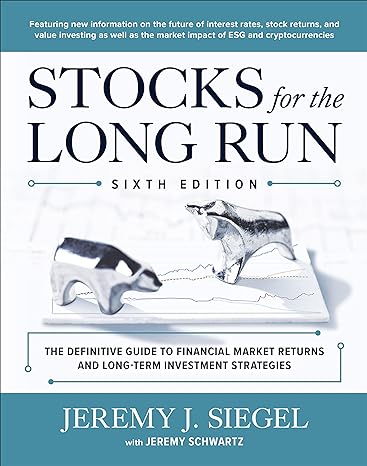Overview : Stocks for the Long Run
- Book Title: Stocks for the Long Run
- Author: Jeremy Siegel
- Publication Date: October 1994
- price: $29.99
- Pages: 450
Overview of the Book
Jeremy J. Siegel is a renowned economist, professor of finance at the Wharton School of the University of Pennsylvania, and a leading authority on long-term investment strategies. His seminal book, Stocks for the Long Run, is considered a classic in investment literature.
Introduction
In the ever-evolving world of finance and investing, few books have stood the test of time quite like Jeremy Siegel's "Stocks for the Long Run." First published in 1994 and now in its fifth edition, this seminal work continues to shape the way investors approach the stock market. As a professor at the Wharton School of the University of Pennsylvania, Siegel brings academic rigor and real-world insights to this comprehensive guide on long-term equity investing.
Book Summary and Key Themes
At its core, "Stocks for the Long Run" makes a compelling case for the superiority of stocks as a long-term investment vehicle. Siegel's thesis is built on a foundation of extensive historical data, spanning over two centuries of market performance. Through meticulous analysis, he demonstrates that equities have consistently outperformed other asset classes, including bonds and treasury bills, over extended periods.
Key themes explored in the book include:
- The power of compound growth in equity markets
- The relationship between risk, return, and time horizon
- The impact of inflation on various asset classes
- The crucial role of dividends in total returns
- Strategies for portfolio construction and management
Analysis of Themes
Historical Perspective and Data-Driven Insights
Siegel's use of historical data is one of the book's strongest assets. By analyzing market returns over 200 years, he provides readers with a unique long-term perspective that cuts through short-term noise. This approach is particularly valuable in today's fast-paced market environment, where investors are bombarded with daily headlines and short-term fluctuations.
The Case for Long-Term Equity Investment
The author's advocacy for a buy-and-hold strategy challenges the notion of market timing, which has become increasingly prevalent in the age of high-frequency trading and algorithmic investing. Siegel's insights serve as a reminder that patient, disciplined investing can yield superior results compared to reactive, short-term approaches.
"Far more money has been lost by investors preparing for corrections, or trying to anticipate corrections, than has been lost in corrections themselves." - Jeremy Siegel
Risk, Return, and Volatility
Siegel doesn't shy away from discussing the risks associated with stock investing. However, he presents a nuanced view of volatility, explaining how it diminishes over longer time horizons. This perspective is crucial for investors navigating today's market landscape, where volatility can be exacerbated by factors such as geopolitical events, technological disruptions, and even social media trends.
Inflation and Its Impact on Investments
The book's analysis of inflation's impact on various asset classes is particularly relevant in the current economic climate. With inflation concerns resurfacing globally, Siegel's insights into stocks as an inflation hedge provide valuable guidance for investors seeking to preserve purchasing power over the long term.
The Role of Dividends in Long-Term Returns
Siegel's emphasis on the importance of dividends offers a refreshing perspective in an era often focused on growth stocks and capital appreciation. His analysis of how reinvested dividends contribute to compound growth is eye-opening and serves as a reminder of the power of income-generating investments.
Writing Style and Accessibility
Despite tackling complex financial concepts, Siegel manages to present his ideas in a clear, accessible manner. The book strikes a balance between academic rigor and practical advice, making it suitable for both novice investors and seasoned professionals. Siegel's use of charts, graphs, and historical examples helps illustrate key points and enhances the reader's understanding of complex market dynamics.
Strengths and Weaknesses
Strengths:
- Comprehensive historical analysis
- Clear, data-driven arguments
- Practical investment strategies
- Timeless principles applicable to various market conditions
Weaknesses:
- Limited coverage of emerging market trends (e.g., cryptocurrencies)
- Some readers may find the extensive use of data overwhelming
- The focus on U.S. markets may not fully address global investment opportunities
Comparison to Other Works
While "Stocks for the Long Run" shares some similarities with other investment classics like Benjamin Graham's "The Intelligent Investor" or Burton Malkiel's "A Random Walk Down Wall Street," Siegel's work stands out for its comprehensive historical analysis and focus on long-term equity performance. Compared to more recent works like "The Simple Path to Wealth" by JL Collins, Siegel's book offers a deeper dive into market mechanics and economic theory.
Highlights from Stocks for the Long Run Review
- Long-term investing: Emphasizes the importance of holding stocks over long periods to maximize returns.
- Historical performance: Reviews stock market trends and growth over the past century.
- Diversification: Advocates for spreading investments across various sectors to reduce risk.
- Global investment: Suggests diversifying internationally to capture growth in emerging markets.
- Risk vs. reward: Analyzes the balance between potential returns and investment risks.
- Market cycles: Discusses how markets go through periods of boom and bust, but long-term growth is likely.
Conclusion and Recommendation
Jeremy Siegel's "Stocks for the Long Run" remains an indispensable resource for investors seeking to build long-term wealth through the stock market. Its blend of historical analysis, practical advice, and timeless investment principles provides a solid foundation for navigating the complexities of modern financial markets.
Whether you're a novice investor looking to understand the basics of equity investing or a seasoned professional seeking to refine your long-term strategy, this book offers valuable insights and perspective. In an era of short-term thinking and market volatility, Siegel's emphasis on patience, discipline, and long-term growth serves as a much-needed anchor for investors.





